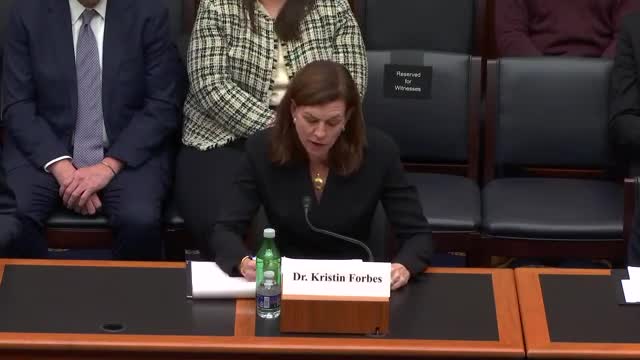MIT economist warns of vulnerabilities in US Treasury market impacting monetary policy
April 09, 2025 | Financial Services: House Committee, Standing Committees - House & Senate, Congressional Hearings Compilation
This article was created by AI summarizing key points discussed. AI makes mistakes, so for full details and context, please refer to the video of the full meeting. Please report any errors so we can fix them. Report an error »

The U.S. House Committee on Financial Services convened on April 9, 2025, to address pressing issues surrounding U.S. Treasury debt and its implications for the monetary system. The meeting highlighted the critical role of a well-functioning Treasury market in supporting economic prosperity, while also acknowledging the challenges it currently faces.
The session began with an economist from MIT Sloan School of Management presenting a detailed analysis of the U.S. Treasury market. He emphasized that the market is essential for funding government operations and serves as a benchmark for borrowing costs across various sectors, including mortgages and loans. However, he noted that recent volatility has exposed underlying fragilities that could threaten its efficiency.
Four key developments were identified as contributing to the vulnerabilities of the Treasury market:
1. **Increased Treasury Issuance**: The Congressional Budget Office (CBO) forecasts a budget deficit of nearly $2 trillion for the year, necessitating significant new debt issuance. A growing proportion of this debt consists of short-term Treasury bills, which require annual rollovers, increasing the market's susceptibility to shocks.
2. **Limited Intermediation Capacity**: The ability of broker-dealers to facilitate transactions in the Treasury market has not kept pace with its expansion. This limitation raises concerns about liquidity, pricing efficiency, and potential spikes in borrowing costs.
3. **Changing Investor Landscape**: There has been a shift in the types of entities purchasing U.S. government debt. While foreign investment has decreased, U.S. institutions, particularly hedge funds and asset managers, have increased their holdings. These investors often employ high-leverage strategies that could lead to market dysfunction during periods of stress.
4. **Geopolitical and Economic Shifts**: Changes in global alliances and trade restrictions may diminish demand for U.S. dollars and Treasuries. If foreign investors become wary of potential losses due to inflation or currency depreciation, it could trigger sudden sell-offs, exacerbating market instability.
The economist also addressed the broader implications for monetary policy, noting that disruptions in the Treasury market could hinder the Federal Reserve's ability to manage inflation and support employment. He underscored the importance of maintaining central bank independence, which is increasingly under pressure globally.
In conclusion, the committee recognized the historic moment facing the Treasury market, marked by significant debt increases and evolving global dynamics. The discussions underscored the urgent need for effective policy responses to mitigate risks and ensure the stability of the U.S. financial system. The committee's work is deemed more critical now than ever, as it navigates these complex challenges.
The session began with an economist from MIT Sloan School of Management presenting a detailed analysis of the U.S. Treasury market. He emphasized that the market is essential for funding government operations and serves as a benchmark for borrowing costs across various sectors, including mortgages and loans. However, he noted that recent volatility has exposed underlying fragilities that could threaten its efficiency.
Four key developments were identified as contributing to the vulnerabilities of the Treasury market:
1. **Increased Treasury Issuance**: The Congressional Budget Office (CBO) forecasts a budget deficit of nearly $2 trillion for the year, necessitating significant new debt issuance. A growing proportion of this debt consists of short-term Treasury bills, which require annual rollovers, increasing the market's susceptibility to shocks.
2. **Limited Intermediation Capacity**: The ability of broker-dealers to facilitate transactions in the Treasury market has not kept pace with its expansion. This limitation raises concerns about liquidity, pricing efficiency, and potential spikes in borrowing costs.
3. **Changing Investor Landscape**: There has been a shift in the types of entities purchasing U.S. government debt. While foreign investment has decreased, U.S. institutions, particularly hedge funds and asset managers, have increased their holdings. These investors often employ high-leverage strategies that could lead to market dysfunction during periods of stress.
4. **Geopolitical and Economic Shifts**: Changes in global alliances and trade restrictions may diminish demand for U.S. dollars and Treasuries. If foreign investors become wary of potential losses due to inflation or currency depreciation, it could trigger sudden sell-offs, exacerbating market instability.
The economist also addressed the broader implications for monetary policy, noting that disruptions in the Treasury market could hinder the Federal Reserve's ability to manage inflation and support employment. He underscored the importance of maintaining central bank independence, which is increasingly under pressure globally.
In conclusion, the committee recognized the historic moment facing the Treasury market, marked by significant debt increases and evolving global dynamics. The discussions underscored the urgent need for effective policy responses to mitigate risks and ensure the stability of the U.S. financial system. The committee's work is deemed more critical now than ever, as it navigates these complex challenges.
View full meeting
This article is based on a recent meeting—watch the full video and explore the complete transcript for deeper insights into the discussion.
View full meeting